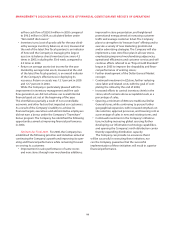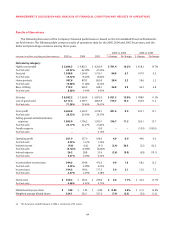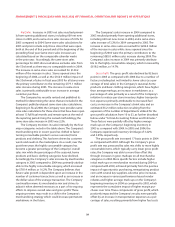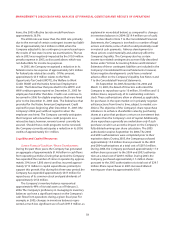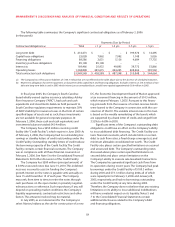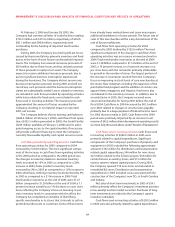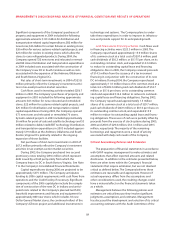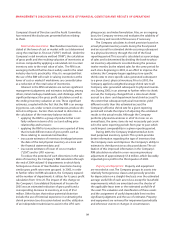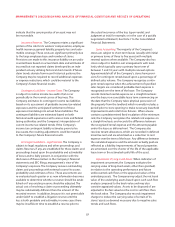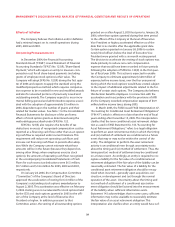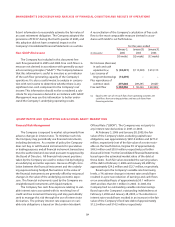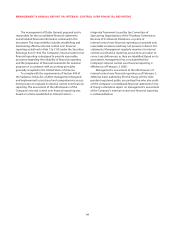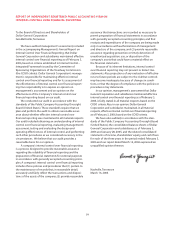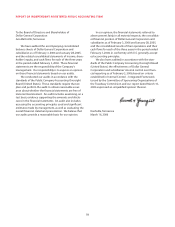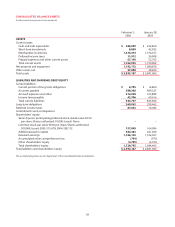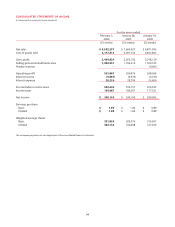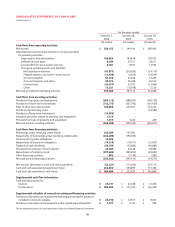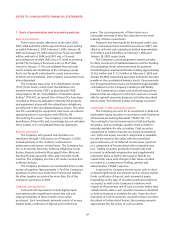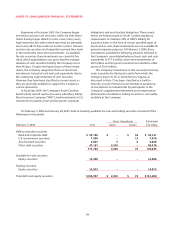Dollar General 2005 Annual Report Download - page 32
Download and view the complete annual report
Please find page 32 of the 2005 Dollar General annual report below. You can navigate through the pages in the report by either clicking on the pages listed below, or by using the keyword search tool below to find specific information within the annual report.
28
MANAGEMENT’S DISCUSSION AND ANALYSIS OF FINANCIAL CONDITION AND RESULTS OF OPERATIONS
Effects of Inflation
The Company believes that inflation and/or deflation
had a minimal impact on its overall operations during
2005, 2004 and 2003.
Accounting Pronouncements
In December 2004, the Financial Accounting
Standards Board (“FASB”) issued Statement of Financial
Accounting Standards (“SFAS”) No. 123(R),“Share-Based
Payment,” which will require an entity to measure com-
pensation cost for all share-based payments (including
grants of employee stock options) at fair value. The
Company will adopt SFAS No. 123(R) during the first quar-
ter of 2006 and expects to apply the standard using the
modified prospective method, which requires compensa-
tion expense to be recorded for new and modified awards
and also for unvested portions of previously issued and
outstanding awards.The Company expects to incur incre-
mental Selling,general and administrative expense associ-
ated with the adoption of approximately $5 million in
2006, dependent upon the number of grants and their
related fair market values. See Note 1 to the Consolidated
Financial Statements for disclosure of the pro forma
effects of stock option grants as determined using the
methodology prescribed under SFAS No. 123.
SFAS No. 123(R) also requires the benefits of tax
deductions in excess of recognized compensation cost be
reported as a financing cash flow, rather than as an operat-
ing cash flow as required under current literature.This
requirement will reduce net operating cash flows and
increase net financing cash flows in periods after adop-
tion. While the Company cannot estimate what those
amounts will be in the future (because they depend on,
among other things, when employees exercise stock
options), the amounts of operating cash flows recognized
in the accompanying Consolidated Statements of Cash
Flows for such excess tax deductions were $6.5 million,
$9.7 million and $14.6 million for 2005, 2004 and 2003,
respectively.
On January 24, 2006, the Compensation Committee
(“Committee”) of the Company’s Board of Directors
approved the acceleration of vesting for 6.4 million of the
Company’s outstanding stock options awarded prior to
August 2, 2005. This acceleration was effective on February
3, 2006. Vesting was not accelerated for stock options held
by the CEO and stock options granted in 2005 to the offi-
cers of the Company at the level of Executive Vice
President or higher. In addition, pursuant to that
Committee action, the vesting of all outstanding options
granted on or after August 2, 2005 but prior to January 24,
2006, other than options granted during that time period
to the officers of the Company at the level of Executive
Vice President or higher, accelerated effective as of the
date that is six months after the applicable grant date.
Certain options granted on January 24, 2006 to certain
newly hired officers below the level of Executive Vice
President were granted with a six-month vesting period.
The decision to accelerate the vesting of stock options was
made primarily to reduce non-cash compensation
expense that would have been recorded in future periods
following the adoption of SFAS No. 123(R) in the first quar-
ter of fiscal year 2006. This action is expected to enable
the Company to eliminate approximately $28 million of
expense, before income taxes, over the four year period
during which the stock options would have vested, subject
to the impact of additional adjustments related to the for-
feiture of certain stock options. The Company also believes
this decision benefits employees. In connection with the
acceleration and in accordance with the provisions of APB
25, the Company recorded compensation expense of $0.9
million, before income taxes, during 2005.
In March 2005, the FASB issued FASB Interpretation 47,
“Accounting for Conditional Asset Retirement Obligations”
(“FIN 47”), which is effective no later than the end of fiscal
years ending after December 15, 2005.This Interpretation
clarifies that the term conditional asset retirement obliga-
tion as used in FASB Statement No. 143,“Accounting for
Asset Retirement Obligations,” refers to a legal obligation
to perform an asset retirement activity in which the timing
and (or) method of settlement are conditional on a future
event that may or may not be within the control of the
entity. The obligation to perform the asset retirement
activity is unconditional even though uncertainty exists
about the timing and (or) method of settlement. Thus, the
timing and (or) method of settlement may be conditional
on a future event. Accordingly, an entity is required to rec-
ognize a liability for the fair value of a conditional asset
retirement obligation if the fair value of the liability can be
reasonably estimated. The fair value of a liability for the
conditional asset retirement obligation should be recog-
nized when incurred—generally upon acquisition, con-
struction, or development and (or) through the normal
operation of the asset. Uncertainty about the timing and
(or) method of settlement of a conditional asset retire-
ment obligation should be factored into the measurement
of the liability when sufficient information exists.
Statement 143 acknowledges that in some cases, sufficient
information may not be available to reasonably estimate
the fair value of an asset retirement obligation. This
Interpretation also clarifies when an entity would have suf-


